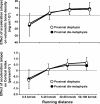Proximal tibia volumetric bone mineral density is correlated to the magnitude of local acceleration in male long-distance runners
- PMID: 20133440
- PMCID: PMC2913800
- DOI: 10.1152/japplphysiol.00865.2009
Proximal tibia volumetric bone mineral density is correlated to the magnitude of local acceleration in male long-distance runners
Abstract
The beneficial effect of physical exercise on bone mineral density (BMD) is at least partly explained by the forces exerted directly on the bones. Male runners present generally higher BMD than sedentary individuals. We postulated that the proximal tibia BMD is related to the running distance, as well as to the magnitude of the shocks (while running) in male runners. A prospective study (three yearly measurements) included 81 healthy male subjects: 16 sedentary lean subjects, and 3 groups of runners (5-30 km/wk, n = 19; 30-50 km/wk, n = 29; 50-100 km/wk, n = 17). Several measurements were performed at the proximal tibia level: volumetric BMD (vBMD) and cortical index (CI), i.e., an index of cortical bone thickness and peak accelerations (an index of shocks during heel strike) while running (measured by a three-dimensional accelerometer). A general linear model assessed the prediction of vBMD or CI by 1) simple effects (running distance, peak accelerations, time); and 2) interactions (for instance, if vBMD prediction by peak acceleration depends on running distance). CI and vBMD 1) increase with running distance to reach a plateau over 30 km/wk; and 2) are positively associated with peak accelerations over 30 km/wk. Running may be associated with high peak accelerations to have beneficial effects on BMD. More important strains are needed to be associated with the same increase in BMD during running sessions of short duration than those of long duration. CI and vBMD are associated with the magnitude of the shocks during heel strike in runners.
Figures



Similar articles
-
Bone mass and geometry of the tibia and the radius of master sprinters, middle and long distance runners, race-walkers and sedentary control participants: a pQCT study.Bone. 2009 Jul;45(1):91-7. doi: 10.1016/j.bone.2009.03.660. Epub 2009 Mar 28. Bone. 2009. PMID: 19332164 Free PMC article.
-
Site and sex effects on tibia structure in distance runners and untrained people.Med Sci Sports Exerc. 2012 Aug;44(8):1580-8. doi: 10.1249/MSS.0b013e31824e10b6. Med Sci Sports Exerc. 2012. PMID: 22330024
-
[Tomodensitometry measurements of proximal tibia and acceleration in marathon athletes].Rev Med Suisse Romande. 2004 Feb;124(2):77-9. Rev Med Suisse Romande. 2004. PMID: 15095617 French.
-
Bone volumetric density, geometry, and strength in female and male collegiate runners.Med Sci Sports Exerc. 2009 Nov;41(11):2026-32. doi: 10.1249/MSS.0b013e3181a7a5a2. Med Sci Sports Exerc. 2009. PMID: 19812515
-
The measurement of tibial acceleration in runners-A review of the factors that can affect tibial acceleration during running and evidence-based guidelines for its use.Gait Posture. 2019 Jan;67:12-24. doi: 10.1016/j.gaitpost.2018.09.017. Epub 2018 Sep 14. Gait Posture. 2019. PMID: 30248663 Review.
Cited by
-
Kinematic variability, fractal dynamics and local dynamic stability of treadmill walking.J Neuroeng Rehabil. 2011 Feb 24;8:12. doi: 10.1186/1743-0003-8-12. J Neuroeng Rehabil. 2011. PMID: 21345241 Free PMC article.
-
Is This the Real Life, or Is This Just Laboratory? A Scoping Review of IMU-Based Running Gait Analysis.Sensors (Basel). 2022 Feb 23;22(5):1722. doi: 10.3390/s22051722. Sensors (Basel). 2022. PMID: 35270869 Free PMC article.
-
Reliability of analysis of the bone mineral density of the second and fifth metatarsals using dual-energy x-ray absorptiometry (DXA).J Foot Ankle Res. 2017 Nov 28;10:52. doi: 10.1186/s13047-017-0234-1. eCollection 2017. J Foot Ankle Res. 2017. PMID: 29209416 Free PMC article.
References
-
- Aminian K. Human movement capture and their clinical applications. In: Computational Intelligence for Movement Sciences: Neural Network, Support Vector Machines and other Emerging Techniques, edited by Begg R, Palaniswami M. Hershey, PA: Idea Group, 2006, p. 101–138
-
- Armitage P, Berry G, Matthews JNS. Statistical Methods in Medical Research. Malden, MA: Blackwell Science, 2005, p. 817
-
- Bass SL, Eser P, Daly R. The effect of exercise and nutrition on the mechanostat. J Musculoskelet Neuronal Interact 5: 239–254, 2005 - PubMed
-
- Bennell KL, Malcolm SA, Khan KM, Thomas SA, Reid SJ, Brukner PD, Ebeling PR, Wark JD. Bone mass and bone turnover in power athletes, endurance athletes, and controls: a 12-month longitudinal study. Bone 20: 477–484, 1997 - PubMed
-
- Berard A, Bravo G, Gauthier P. Meta-analysis of the effectiveness of physical activity for the prevention of bone loss in postmenopausal women. Osteoporos Int 7: 331–337, 1997 - PubMed
Publication types
MeSH terms
LinkOut - more resources
Full Text Sources
Medical

